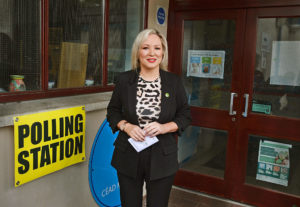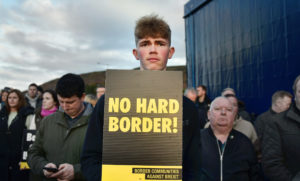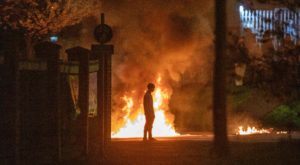The political climate in Northern Ireland has always been reflected in its graffiti. In nationalist and unionist areas, slogans and murals commemorating aspects of the Troubles are still common, though the paramilitary emphasis has declined in recent decades. Years ago, a particularly unsettling mural in Derry depicted a skeleton waving a Union Jack, dressed in army fatigues and trampling over dead Catholics on a battlefield. In the background, you could see the Bogside — a republican area of the city — razed to the ground and still burning.
Such provocative imagery may no longer exist, but today’s graffiti is just as revealing as ever. If you wander around the staunchly unionist areas of Belfast and Derry, you will note a few recurring phrases that express the extent of the opposition to the Northern Ireland Protocol. “No Surrender”, which was once the common refrain, has been replaced by “No Irish Sea Border”. With Sinn Féin now the largest political party in the region, and the Catholic population outnumbering Protestants for the first time, whisperings of a united Ireland are growing in volume. Sinn Féin’s Michelle O’Neill has already spoken of a “unity referendum”, and the DUP’s Philip Brett has cautioned against seeing the most recent census as “some sort of mini-referendum on the position of Northern Ireland in the UK”.
At the same time, the graffiti in unionist areas is whispering its own refrains, often more ominous in tone. Just before Christmas last year, the phrase “war is needed” appeared on a gable wall in Newtownards, while port staff in Larne and Belfast were branded “active targets” in graffiti close to the Mourneview Community Centre. Such appalling threats — although the work of dissidents with no mandate from the Protestant community — are the more extreme manifestation of a siege mentality that has persisted since the Troubles. In the Fountain estate, a Protestant area on the largely Catholic west side of Derry’s River Foyle, one mural has remained unaltered for decades. It bears the words “Londonderry West Bank Loyalists Still Under Siege”.
The ongoing political turmoil in Westminster has only exacerbated this sense of uncertainty. Rishi Sunak is said to favour a more conciliatory approach to the Protocol, and has expressed concerns about the “stability of the situation”. His reappointed Northern Ireland Secretary, Chris Heaton-Harris, is currently holding talks at Stormont in an effort to restore the executive before tomorrow’s deadline. If he fails and an election is called, as seems certain, the impasse will surely persist into the new year.
Yet we should be wary of those with the tendency to catastrophise. For the past year, we have seen numerous commentators and politicians raising the spectre of a return to civil unrest. The late David Trimble wrote that the resentments generated by the Protocol could encourage “those who have engaged in past violence to take action again into their own hands”. More recently, Tony Blair has warned that “the issues at the heart of the Protocol have the capability of causing an enlarged trade conflict between the UK and the EU, or undermining the Good Friday Agreement — and quite possibly both”.
Such pessimism may be sincere, but it fails to consider that there are no straightforward solutions to this dispute. Like so many agreements relating to Northern Ireland, the Protocol was always a kind of fudge. Boris Johnson repeatedly used the phrase “over my dead body” when asked about the possibility of a border down the Irish Sea but, as Lord Frost has since admitted, the Government always knew the treaty was “far from perfect”.
Is a return to violence a genuine possibility? I’m inclined to believe that such talk is often politically motivated and needlessly alarmist. The conditions which gave rise to the Troubles in the late Sixties were incomparable with the tensions that exist today. And although threats from paramilitary dissident groups are not to be taken lightly, there is simply no desire among the general population for a return to those terrible years.
After all, the Troubles were not brought about solely due to grievances rooted in identity, but rather the tangible inequalities of a state that was built upon sectarianism. The Fourth Home Rule Bill, passed in 1920 and implemented the following year, saw Ireland partitioned in such a way that Protestant dominance could be guaranteed. Stormont was, as James Craig was later to assert, “a Protestant parliament for a Protestant people”.
By the Sixties, there had been decades of discrimination. Those with Catholic-sounding surnames were accustomed to having their job applications overlooked. Living conditions for Catholics were generally dire. Yet Westminster cared little for the injustices taking place on its doorstep. In his book Provos (1997), the journalist Peter Taylor estimates that the time spent discussing Northern Ireland in the House of Commons “averaged less than two hours a year”.
As the area with the highest Catholic population, Derry was always likely to be the location where civil unrest would first erupt. Resignation had given way to resentment, and the political gerrymandering was so egregious that it could not be ignored forever. The electoral lines had been rigged so that even though two-thirds of the city were Catholic, they could only elect eight out of the 20 councillors.
Yet for all that, the Derry Housing Action Committee (DHAC) — a civil rights group that formed in 1968 — was explicitly non-sectarian. Although Catholics were disproportionately affected by poor housing conditions, the problems extended to members of the working-class Protestant community. With the support of the Northern Ireland Civil Rights Association (NICRA), the DHAC scheduled a march on 5 October 1968 to protest against the unfair allocation of housing and jobs, and the injustices of electoral manipulation. The violence that ensued at this march is typically cited as the beginning of the Troubles.
Earlier this month, the surviving organisers gathered to commemorate their march at the location where it began: the Waterside railway station. A photograph of the key activists appeared in the Belfast Telegraph. It featured my uncle, Eamon Melaugh, along with Eamonn McCann and Dermie McClenaghan. Their march was not the first of its kind, but it was the first to be covered on TV, and therefore exposed the violence of the RUC (Royal Ulster Constabulary) against the protesters. My uncle has explained to me that this was a deliberate tactic. He had contacted various journalists in the days leading up to the event, and from the outset he had seen it as an opportunity to lay bare the sectarianism of the state to an international audience.
In War and an Irish Town (1974), McCann describes how the organisers from the DHAC had relied on their new associates’ naivety to convince them to accept a route that would doubtless result in violent confrontation. He recalls a pep-talk my uncle had given to the DHAC members before meeting with the NICRA representatives in a room over a pub in William Street: “Remember — our main purpose here is to keep our grubby proletarian grip on this jamboree.”
“When I went out on the Saturday to march,” my uncle told me, “I knew what was coming. I had six white hankies in my pockets to act as bandages, and that’s exactly what they were used for. The police were all waiting for us with drawn batons. I selected that route to provoke them into violence. And I told the marchers: when our blood flows, Stormont goes.”
This was all a far cry from the circumstances of today. The unionist community is united in its condemnation of the Protocol, but would this threat to collective national identity be a justification for a return to violence? The possibility of terrorist activity is real and ongoing; only last month, there were flagrantly sectarian attacks on four Catholic homes in the village of Culnady. But at the risk of tempting fate, widespread civil unrest on the scale of the Troubles seems unimaginable.
That said, our political class would be advised to be more sensitive to the concerns of unionists who increasingly feel as though they are being sidelined. This isn’t simply a question of Northern Ireland’s businesses being subject to EU regulations, or even the economic impact of the Protocol; the constitutional implications are far more concerning.
Those familiar with Northern Ireland’s history will know that the prospect of a united Ireland has always provoked resistance in the form of direct action. The Sunningdale Agreement of 1973 was brought down by the Ulster Workers’ Council strike and terrorist attacks by the UDA and UVF. The Anglo-Irish Agreement of 1985, which gave the Irish government a role in the affairs of Northern Ireland, was greeted with mass strikes, rallies and civil disobedience from unionists. An effigy of Margaret Thatcher was burned outside Belfast City Hall.
This is the context in which Michelle O’Neill’s reference to a prospective “unity referendum” should be understood. Some unionists have vowed to leave Northern Ireland should a majority vote for unification, but violent reprisals from a sizeable minority would also be expected. A political solution is necessary, albeit difficult to envisage in the current circumstances.
The DUP’s position — that the Protocol is fundamentally incompatible with the Good Friday Agreement — is non-negotiable, which rules out the prospect of a unity government. Former first minister Paul Givan has said it will take a “miracle” for a new executive to come to fruition before tomorrow’s deadline. Even with hopes resting on a December election, the current stalemate seems indefinite.
Yet the history of Northern Irish politics is a series of broken deadlocks. In the Sixties, few could imagine a life beyond the inherent inequalities of a state founded on sectarian principles. In the Nineties, the tortuous negotiations from the Downing Street Declaration to the Good Friday Agreement made it seem as though the peace process was forever on the verge of collapse. It may take a miracle to restore Stormont in its current form, but that doesn’t mean that we should assume the worst for an uncertain future.
Disclaimer
Some of the posts we share are controversial and we do not necessarily agree with them in the whole extend. Sometimes we agree with the content or part of it but we do not agree with the narration or language. Nevertheless we find them somehow interesting, valuable and/or informative or we share them, because we strongly believe in freedom of speech, free press and journalism. We strongly encourage you to have a critical approach to all the content, do your own research and analysis to build your own opinion.
We would be glad to have your feedback.
Source: UnHerd Read the original article here: https://unherd.com/




